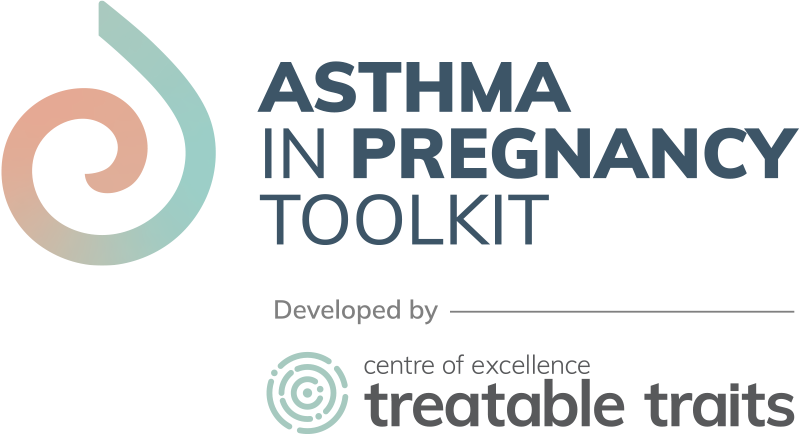Tobacco Smoke
Cigarette smoking by pregnant women is the leading preventable cause of poor pregnancy outcomes.
Tobacco smoke exposure in current smokers or environmental exposure to second-hand smoke is a common trigger of asthma. People with asthma are more likely to smoke than people without asthma, and this has also been shown in pregnancy (Murphy et al. 2010). In an Australian study of pregnant women with asthma published in 2010, 68% of current smokers had a partner who smoked, while 33% of ex-smokers and only 16% of never smokers had a partner who smoked (Murphy et al. 2010). Similarly, smoking by visitors outside the home was significantly more likely among current smokers. In pregnancy, women with asthma who smoke cigarettes had more frequent and more severe exacerbations compared to women who never smoked (Murphy et al. 2010).
Smoking in pregnancy or in a child’s early life also increases the risk of poor lung health for the infant. An American study of more than 100,000 infants, showed that both maternal asthma and maternal smoking were risk factors for having at least one health care visit for bronchiolitis in infancy (Carroll et al. 2007). One third of mothers with asthma were also smokers in this study. The highest rate of bronchiolitis was among children of mothers with asthma who smoked (30%), followed by asthma only (24%). The adjusted odds ratio for emergency department visits for infant bronchiolitis was 1.55 (95% CI 1.37, 1.76) for mothers with asthma, and 2.18 (95% CI 1.87, 2.54) for mothers with asthma who smoked (Carroll et al. 2007).
Smoking cessation is recommended during pregnancy for all women. For women with asthma, this may improve their own lung health in addition to benefits for their pregnancy outcomes and their baby’s lung development.
E-cigarettes / vaping
Electronic cigarettes (or e-cigarettes) are battery operated devices which deliver nicotine, flavouring and other constituents to the user by heating the liquid to a temperature which forms aerosols. Vaping e-cigarettes can result in inhalation of a wide variety of different chemical aerosol mixtures, including potentially harmful carbonyls (Clapp & Jaspers 2017). Some of the flavouring agents used in e-cigarettes are similar to known airway irritants and sensitizers which have been identified to cause occupational asthma (Clapp & Jaspers 2017).
The prevalence of cigarette smoking in pregnancy is falling, however, at the same time, the use of e-cigarettes has increased in recent years (Hawkins & Hackner 2022). Data from 15 studies in adolescents and adults showed that e-cigarette use is associated with a 39% increased odds of having asthma after adjusting for cigarette smoking (Wills et al. 2021). However, there is currently very little data on the long-term effects of e-cigarette use on exacerbations of asthma. Current data does not support substituting e-cigarettes for cigarettes as a better option for people with asthma who smoke (Clapp & Jaspers 2017).
Laboratory studies show that e-cigarettes have harmful effects on biological processes including cytotoxicity, oxidative stress and inflammation, susceptibility to infection and DNA damage, all processes that are linked to poor respiratory outcomes (Wills et al. 2021).
There is limited human data on pregnancy outcomes following e-cigarette use. A US study of pregnant women between 2013 to 2019 found that 1% used e-cigarettes, while 3.2% used e-cigarettes with another tobacco product (Cohn et al. 2022). While there was no effect of e-cigarette use on adverse pregnancy outcomes in this study of 1037 pregnant women, there was also no improvement in outcomes such as preterm birth or low birth weight, with e-cigarette use compared to cigarette use.
A 2022 study examined the effect of e-cigarette use and cigarette smoking on small for gestational age babies (Shittu et al. 2022). The highest rate of SGA was for women who used both e-cigarettes and cigarettes before and during pregnancy (23.2%). Continuing e-cigarette use in pregnancy had a similar effect on SGA as smoking cigarettes during pregnancy (>16% SGA, Table). However, quitting cigarette smoking by switching to e-cigarettes reduced SGA to a similar rate as non-smokers.

Rate of small for gestational age babies in smokers of e-cigarettes and cigarettes before and during pregnancy (Shittu et al. 2022)
In pregnancy, the use of e-cigarettes still results in exposure of the fetus to nicotine. While animal studies show abnormal lung growth and branching, an increased respiratory rate and airway resistance, similar to findings in offspring of smoking mothers, there are no human studies which have considered infant and childhood respiratory outcomes following a pregnancy exposed to e-cigarettes (Bednarczuk et al. 2022).
